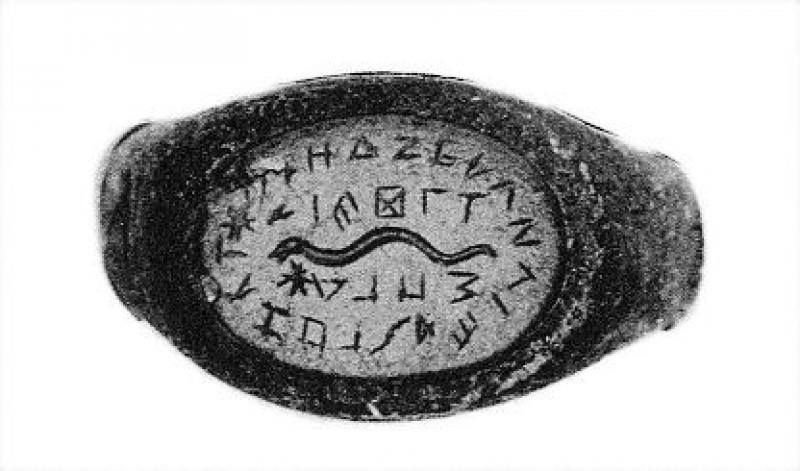Bonner, SMA, 319.
Lapis lazuli mottled with white. Upright oval, 20 X 11 X 3.5.
A very similar design, but apparently more neatly executed, appears on a stone illustrated in Matter, Pl. 8, 2. Even the reverse inscriptions are the same, with the exception of a single letter. The design is a rare variation from the type of the solar deity mounted on a lion.
384
Obv. Man standing to front, nude, two snakes twining round his waist, spear held upright in r. hand, a twig with three leaves or flowers in l. Hair turned back in a prominent roll. Round margin, beginning at top, συριμμαλκεμθειπαιαμαρμαραιω; several letters uncertain. Above the twig, θεo, below, εηασυ. Between spear and r. leg, ψεω.
Rev. εφρυαρια.
Ironstone, probably limonite. Upright oval, 16 X 12 X 4.
385
Newell 7
Obv. Two women facing each other and holding shoulder-high a vessel shaped like an Attic lebes but with two short handles near the rim. The figure on the right supports the vessel with her r. hand, and holds a short wand downward in her l. The left-hand figure is in a half-sitting posture but the chair is barely indicated; under it is an uncertain object drawn with short crossing lines, lying at an angle to the perpendicular. This woman holds the bowl with her l. hand, while her r. grasps a staff crossed by six short bars. Both figures wear long tunics with upper garment wrapped diagonally about the body. Two stars above. Between the figures Al, in field at right, another A.
Rev. Plain.
Dark red jasper shaded with green. Horizontal oval, 20 X 17.5 Χ 4.5.
386
Obv. At l., mummy standing to r., wrapped from neck to feet in a network of bandages. The head is bare; face apparently bearded; hair bound in the Greek style. At r., a crudely executed flying creature, evidently meant for a bird, but with the wings attached in an impossible manner. Above it, a star.
Rev. Plain.
Dark-green jasper. Upright oval, 18.5 X 15 X 2. Chipped at bottom and at upper r. edge.
387
Obv. Combination of a bearded mask facing l., supported on cock's legs; a horse's head and neck (above at l.) bridled, a wreath in the horse's mouth; a cornucopia, above, at r., a ram's head (behind the mask), holding in the mouth an ear of grain and an acorn-shaped object meant for a bunch of grapes. Palm frond under the cock's feet. At the upper r. edge, AY; at l. edge, star, crescent, and KO.
Deep red carnelian. Upright oval, 16 X 13 X 5. Both sides convex, obv. more so. Edge beveled.
This is a fair example of the so-called “grylli,” a name which really means “caricatures,” but has long been applied to curious combined designs. Such types are very common; they were probably apotropaic, a magical power being imputed to them because of their strangeness. Combinations like this specimen are published in Walters, B. M. Cat. Gems 2573–2575 and 2600 (Pl. 29); Richter, Cat. Metrop. Mus. 274 (Pl. 68); Furtwängler, Antike Gemmen, Pl. 46, 33; Beschreibung, 3341, 3344 (Pl. 27).
388
Obv. Snake moving to l., star under its head, another above and to l. Round margin, a series of Greek letters and two signs that cannot be so called. Within this inscription there is a shorter one consisting of four letters and a character over the snake, and four letters under it. Entirely unintelligible.
Rev. Plain.
Brown carnelian set in ancient iron ring. The stone measures 17 X 7; inside
Last modified: 2012-11-13 22:05:29
Link: cbd.mfab.hu/pandecta/1775




